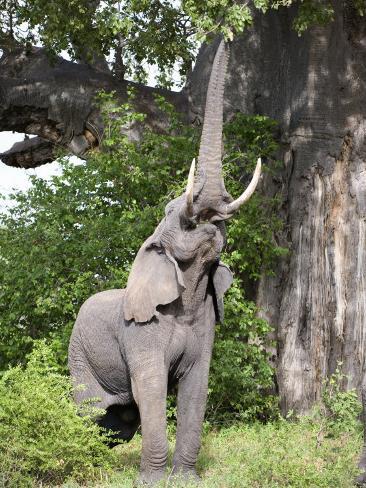Wednesday, February 15, 2012
Tuesday, February 14, 2012
Elephant Knocking Down Tree
Keystone Species: Elephants
Elephants are keystone species, because they feed on and destroy trees and plants, clearing land for grass species. Without this, the savannah would not be a grassland, and instead turn into a woodland. All of the other plants and animals who inhabit the savannah all depend on the elephant.
Elephants
To survive the dry climate of the savanna, Elephants have developed a physical structure that enables them to access water stored in places otherwise unreachable, such as the trunk of the Baobab tree.
Soil conditions:
The African Savannah grasslands have a moderately thin layer of topsoil, which supports the grasses , shrubs and scattered trees of the biome. Forest fires and anthropogenic fires clear grass land and keep maintain the fertility of the soil. African soil is mostly porous, and only has low concentrations of humus.
The African Savannah grasslands have a moderately thin layer of topsoil, which supports the grasses , shrubs and scattered trees of the biome. Forest fires and anthropogenic fires clear grass land and keep maintain the fertility of the soil. African soil is mostly porous, and only has low concentrations of humus.
Giraffes
Giraffes have adapted to the savanna, by developing long necks to be able to reach food high up on trees and also sight predators from afar. They are also able to go weeks without water, which helps them survive the savanna's dry climate.
Anthropogenic Environmental Issues
One of the large problems facing the fauna of the African savannah is illegal poaching. Elephant tusks and Rhino horns are very valuable on the black market. The savannah also faces agriculture related issues such overgrazing, and the clearing of native grasslands to grow crops.
Woody regrowth in savanna systems is environmentally desirable to control erosion, supply fuel wood and sequester carbon but farmers dislike regrowth in their fields as it reduces the grazing potential for cattle.
There are actually many factories, mines, houses and farms there, and so air pollution also one of the main threats to Africa’s savannas. The air can be polluted by smoke and exhaust fumes.
Wednesday, February 8, 2012
Bibliography
Sources:
"B… Savanna Main Trees « Almm’s African Savanna: Environment." Almm’s African Savanna: Environment. Web. 16 Feb. 2012. <http://savannaenvironment.wordpress.com/4/>.
Anonymous. "African Lions Satisfy Their Thirst at Water Hole on the Savanna Photographic Print at Art.com." Art.com - Posters, Art Prints, Framed Art, and Wall Art Collections. Web. 16 Feb. 2012. <http://www.art.com/products/p14281328-sa-i2904444/african-lions-satisfy-their-thirst-at-water-hole-on-the-savanna.htm>.
"Backdrop OA 006 African Savannah 5." Backdrops Fantastic - Backdrop Rentals and Sales. Web. 14 Feb. 2012. <http://www.backdropsfantastic.com/backdrop_themes/backdrops/Backdrop_OA006.htm>.
"Backdrop OA 006 African Savannah 5." Backdrops Fantastic - Backdrop Rentals and Sales. Web. 16 Feb. 2012. <http://www.backdropsfantastic.com/backdrop_themes/backdrops/Backdrop_OA006.htm>.
"African Savanna Elephant -- Kids Encyclopedia | Children's Homework Help | Kids Online Dictionary | Britannica." Kids Encyclopedia | Children's Homework Help | Kids Online Dictionary | Britannica. Web. 16 Feb. 2012. <http://kids.britannica.com/comptons/art-55513/African-elephants-live-in-the-area-surrounding-Mount-Kilimanjaro-Tanzania>.
"Image of 'African Buffalos in the Savannah'" Royalty-free Images, Illustrations and Videos for Web and Print. Web. 16 Feb. 2012. <http://www.colourbox.com/image/african-buffalos-in-the-savannah-image-2964969>.
"The Last Great Global Warming." Use Celsias.com - Reduce Global °Celsius. Web. 16 Feb. 2012. <http://www.celsias.com/article/last-great-global-warming/>.
"B… Savanna Main Trees « Almm’s African Savanna: Environment." Almm’s African Savanna: Environment. Web. 16 Feb. 2012. <http://savannaenvironment.wordpress.com/4/>.
Anonymous. "African Lions Satisfy Their Thirst at Water Hole on the Savanna Photographic Print at Art.com." Art.com - Posters, Art Prints, Framed Art, and Wall Art Collections. Web. 16 Feb. 2012. <http://www.art.com/products/p14281328-sa-i2904444/african-lions-satisfy-their-thirst-at-water-hole-on-the-savanna.htm>.
"Backdrop OA 006 African Savannah 5." Backdrops Fantastic - Backdrop Rentals and Sales. Web. 14 Feb. 2012. <http://www.backdropsfantastic.com/backdrop_themes/backdrops/Backdrop_OA006.htm>.
"Backdrop OA 006 African Savannah 5." Backdrops Fantastic - Backdrop Rentals and Sales. Web. 16 Feb. 2012. <http://www.backdropsfantastic.com/backdrop_themes/backdrops/Backdrop_OA006.htm>.
"African Savanna Elephant -- Kids Encyclopedia | Children's Homework Help | Kids Online Dictionary | Britannica." Kids Encyclopedia | Children's Homework Help | Kids Online Dictionary | Britannica. Web. 16 Feb. 2012. <http://kids.britannica.com/comptons/art-55513/African-elephants-live-in-the-area-surrounding-Mount-Kilimanjaro-Tanzania>.
"Image of 'African Buffalos in the Savannah'" Royalty-free Images, Illustrations and Videos for Web and Print. Web. 16 Feb. 2012. <http://www.colourbox.com/image/african-buffalos-in-the-savannah-image-2964969>.
"The Last Great Global Warming." Use Celsias.com - Reduce Global °Celsius. Web. 16 Feb. 2012. <http://www.celsias.com/article/last-great-global-warming/>.
"Major Threats to Savanna Ecosystems."Http://www.ucmp.berkeley.edu/exhibits/biomes/grasslands.php. Ecology and Management to Tropical Forests and Savannas. Web. 16 Feb. 2011. <http://www.ucmp.berkeley.edu/exhibits/biomes/grasslands.php>.
African Elephant Reaching for Baobab Tree Leaves, Tarangire National Park, Tanzani. Digital image. All Posters. Web. 14 Feb. 2011. <http://www.allposters.com/-sp/African-Elephant-Reaching-for-Baobab-Tree-Leaves-Tarangire-National-Park-Tanzania-Posters_i6216962_.htm>.
Digital Image
"Animal Adaptation." Tartu Veeriku Kool - Kodu. Web. 14 Feb. 2012. <http://www.veeriku.tartu.ee/~ppensa/animal_adaptation.html>.
Website
"Earth Floor: Biomes." Earth Floor. 2004. Web. 14 Feb. 2011. <http://www.cotf.edu/ete/modules/msese/earthsysflr/savannahA.html>.
Website
Elephant-destroying-tree. Digital image. Dreamstime. Web. 14 Feb. 2011. <http://www.dreamstime.com/royalty-free-stock-photos-elephant-destroying-tree-image5244588>.
Digital Image
"Keystone Species." Wikipedia, the Free Encyclopedia. Web. 14 Feb. 2012. <http://en.wikipedia.org/wiki/Keystone_species>.
"Major Threats to Savanna Ecosystems."Http://www.ucmp.berkeley.edu/exhibits/biomes/grasslands.php. Ecology and Management to Tropical Forests and Savannas. Web. 16 Feb. 2011. <http://www.ucmp.berkeley.edu/exhibits/biomes/grasslands.php>
Website
Zuckerman, Jim. Description: Giraffe eating from an acacia tree, Maasai Mara Game Reserve, Kenya. Digital image. Betterphoto.com. Web. 14 Feb. 2011. <http://www.betterphoto.com/gallery/dynoGallDetail.asp?photoID=1705295>.
Subscribe to:
Posts (Atom)


















